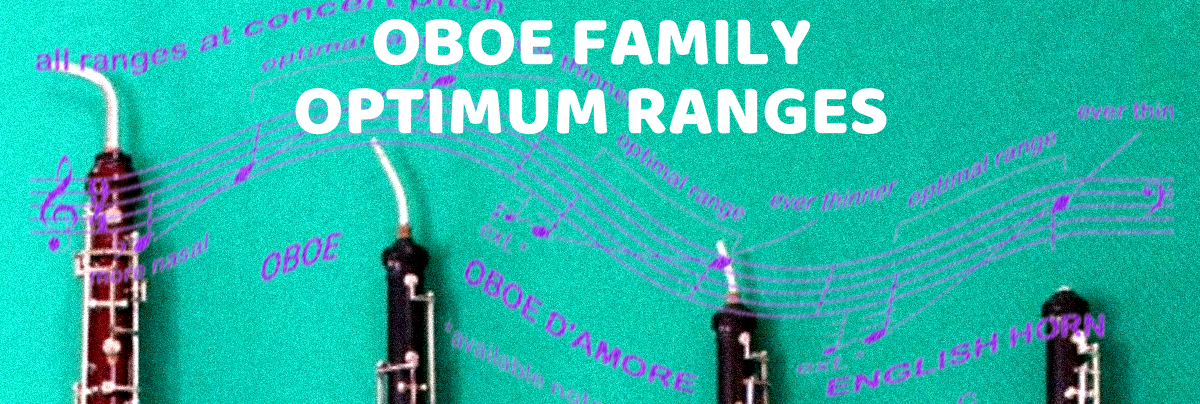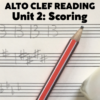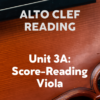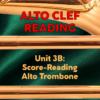The best, most characteristic sound of the oboe comes from its middle octave- and-a-half: from F4 at the bottom of the staff up to B-flat5 above. The optimum registers of lower oboe family members lie in their lower ranges, with implications of a wider separation from the oboe than one might expect.
The previous tips on the oboe have covered phrasing and breath issues, along with extremes of range. But it’s worth writing a few words for you about the optimum range of the oboe, and why it’s the best register for most scoring.
First, let’s define that range: first-space F4 up to first ledger-line B-flat5 above. That gives you 11 diatonic or 18 chromatic pitches with which to score. You’ll find that if you go through most orchestral scores, these boundaries are taken as a general neighbourhood for oboe parts, with a few notes here or there stepping over the line. Some higher notes are used in doubling high string lines or building wind harmonies. Some lower notes are used in very strong passages. But this middle range is the test for an orchestrator: using it well and as a home base shows that you respect the oboe’s essential character (not to mention the player).
Why are those notes the best? Simply because the whole instrument has been designed around that range. The oboe’s design is a distillation of the ancient instrument called the shawm, a rude, blatting, buzzing beast of a thing. Instrument builders thickened the walls and refined the shape of the bore, as well as making the finger holes smaller. The shawm reeds had been encased in the instrument so that only the tiniest tip emerged from the mouthpiece, to make it more playable. The oboe redesign team dispensed with these training wheels and fully exposed the reeds so the player’s lips could control the entire means of tone formation. In the process, they adjusted all these new features to favour a central tessitura in the new instrument’s range.
What this means in practical terms is that embouchure, breath control, intonation, and dynamic smoothness are all at a premium here. It may be an effort to control the forceful mechanism of the breath to get that beautiful flowing, chuckling sound, but the struggle pays off most rewardingly in that range. At the extremes, intonation problems abound, but in the centre, the pitches tend to line up in agreement by comparison. And best of all, the strength of the notes is more even, with fewer pitches that want to leap out at the listener over the flow of a phrase.
The inventors of the oboe didn’t stop there, though. Seemingly aware that a significant portion of usable range was now lost or less enticing, they developed the oboe da caccia, known today by the malaprop name of English horn or cor anglais (probably derived from “cor anglé” – “angled horn). Adapting the same redesign principles, they created an instrument optimised for its lowest range rather than its middle register, with a larger reed, longer bore, and bulbous bell at the end for absorbing certain rougher overtones.
The biggest misconception that many orchestrators have about the English horn is that it represents an extension downwards of a fifth for the oboe’s range. This is technically true but functionally false. The functional truth: in optimal range of expression, the English horn is an extension downward of a full octave. These are the registers which should mirror each other, support each other, and take context from one another. This makes the pitch relationship between the two more like piccolo to flute rather than flute to alto flute. Not that they should necessarily play octaves: the English horn is great at playing close intervals with the oboe, particularly when the oboe is at the bottom of its middle register or even lower. It’s more that the perception of each instrument’s centre more truly defines their relationship than a blunt comparison of their playable ranges.

When this fundamental truth is grasped by the orchestrator, then the ranges and strengths of the other oboe family members become clearer. After all, if we think only of playable range, why bother making an oboe d’amore, with only a whole step’s-worth of difference? But if we compare their optimum registers, we see that they’re a good minor 6th apart.
By the same token, the relationship between the bass oboe family and standard oboes shouldn’t be defined by the octave’s difference in their parallel ranges. Scoring nothing but octaves between these two very different instruments might very well rob both of them of their magical qualities. Their best registers are an octave plus a perfect 4th apart. Even with extensions of the Heckelphone down to low B-flat or A, or the lupophone going even deeper down to low F, the securest and most characteristic range still starts at around sounding C3 up to G4. This means that the bass oboe’s more natural partner in big scoring is the English horn, as the separation is only that of a perfect 4th or so, and the timbres are much more closely related. Think on that should you ever have the incredibly rare opportunity to score for a bass oboe.









